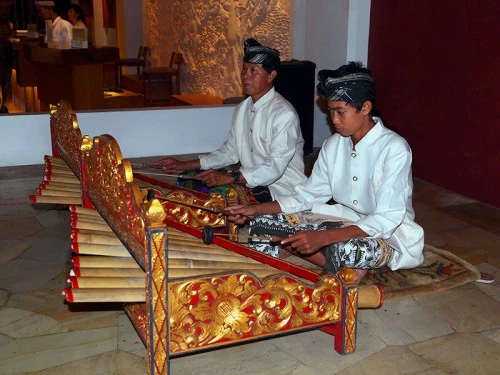More About Rindik Bali: History, Where to Buy it, and How to Use it
What was the first thing that popped into your head when the name ‘Rindik Bali’ appeared? Some of you may not be so familiar with this, but believe me something that uses Balinese words is always fun to discuss. Maybe that will also be the reason why you should know more about Rindik Bali, from its history to how to use it.
What was the first thing that popped into your head when the name ‘Rindik Bali’ appeared? Some of you may not be so familiar with this, but believe me something that uses Balinese words is always fun to discuss. Maybe that will also be the reason why you should know more about Rindik Bali, from its history to how to use it.
What is Rindik Bali?

Rindik Bali, a kind of traditional Balinese musical instrument similar to the xylophone. Crafters select and prepare bamboo pieces specifically for making Rindik. They arrange these pieces at precise distances and beat them with a hammer to produce sound and tone. This process closely resembles the making of the gambang in Javanese gamelan, but with different materials; while the gambang uses metal pieces, the rindik uses bamboo pieces.
The shape itself consists of 11 to 13 neatly arranged bamboo pieces with a small gap in each piece. Each piece of bamboo also has a different size, including the tone it produces. The bigger the piece of bamboo, the lower the tone will be. Conversely, the smaller the bamboo pieces, the higher the tone produced. Usually, the order of placing the largest bamboo pieces is on the left, and the smallest on the right.
History of Rindik Bali

According to goodnewsfromindonesia.id, Rindik Originated from the citizens of Wengker (Ponorogo) who rebelled against the Majapahit kingdom. The citizens of Wengker used a musical instrument called Angklung Reyog as one of their weapons. An attack from the Demak kingdom made them run to Bali while carrying the Angklung Reog and other gamelans.
When the exiles arrived in Bali, they hit a big roadblock. Moving and keeping their big, complicated musical instruments like the gamelan and Angklung Reyog turned out to be a huge hassle. Plus, they didn’t have the means or know-how to make new ones, putting their cherished musical traditions at risk. Faced with these hurdles, they mixed their old traditions with new ideas and created the Rindik, a fresh musical instrument that was perfect for Bali. The Rindik was a beautiful blend of their past and the new world they found themselves in, keeping their musical spirit alive and well in Bali.
Process of Making Rindik
Crafting the Balinese rindik begins with selecting bamboo and cutting it to size. Typically, a rindik will have about 11 to 13 bamboo pieces. Each piece is like its own voice in a choir, with the smaller ones singing high notes and the larger ones humming deeper tones.
To set up the rindik, these bamboo pieces are arranged on a frame, called a pelawah. They put the biggest piece on the far left and the smallest piece takes its spot on the far right. This setup helps in creating a range of sounds that come together to make the rindik’s unique music.

Where to Buy it?
The function of this Rindik musical instrument develops along with the times. In the past, rindik was originally only made as a tool to entertain farmers in the rice fields. Rindik is also commonly used as a musical accompaniment to the folk entertainment Joged Bumbung.
Rindik is still used during festival and celebration, including accompanying dance and other performances. This is why people consider it an essential part of Balinese culture that must be preserved.
If you live in Bali, it’s very easy to get a Rindik because you can easily visit the craftsmen. However, if you want to have it without coming to Bali, you can order Rindik Bali on an online marketplace, or by ordering directly from Rindik craftsmen.

How to Use it?
Rindik consists of 11 to 13 pieces of bamboo. Every bamboo segment in the instrument varies in size and produces a different scale tone. Larger bamboo pieces yield lower tones, while smaller ones create higher tones.
The arrangement of these bamboo segments is sequential, starting with the largest piece on the left and progressing to the smallest on the right. Rindik has 5 main scales because the tone produced by Rindik is of the slendro type.
To play Rindik is quite easy. Both hands hold one stick each with different tasks. The right hand plays the kotekan while the left hand handles the melody; you can reverse this if it’s more comfortable for you.
Rindik is Just One of Many
Rindik Bali is just one of the many traditional musical instruments in Bali. Even though times are a little different because now everything is digital, there’s nothing wrong if you are one of those who continue to preserve it.
If you want to come to Bali, Ubud is probably the best city because it has been a center for the arts for many years. If you need a place to stay for the night, we have the solution. Many private villas in Ubud have beautiful views to relax in. Take a look at Ubud Villa Rentals by Red Lotus to find your match.



